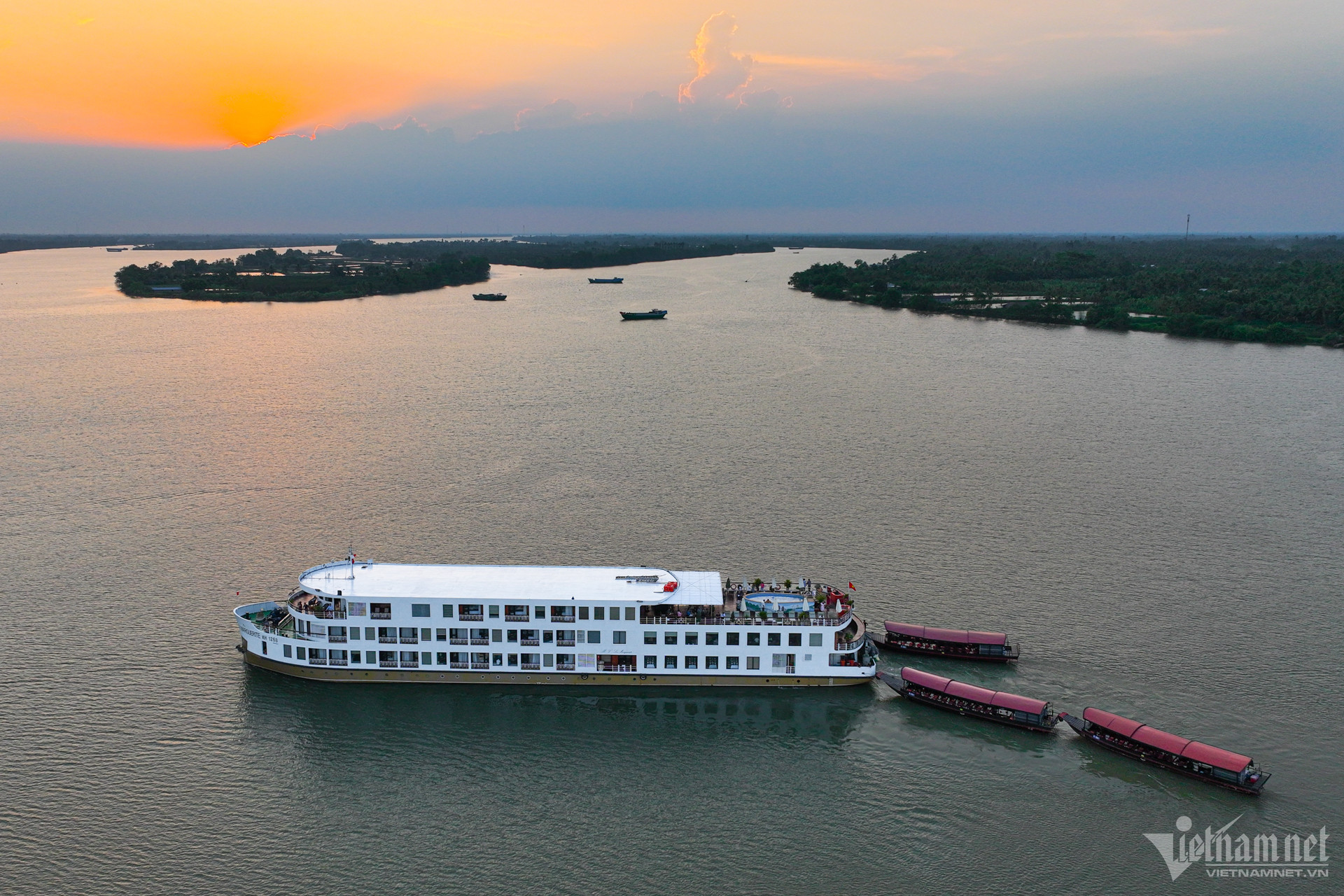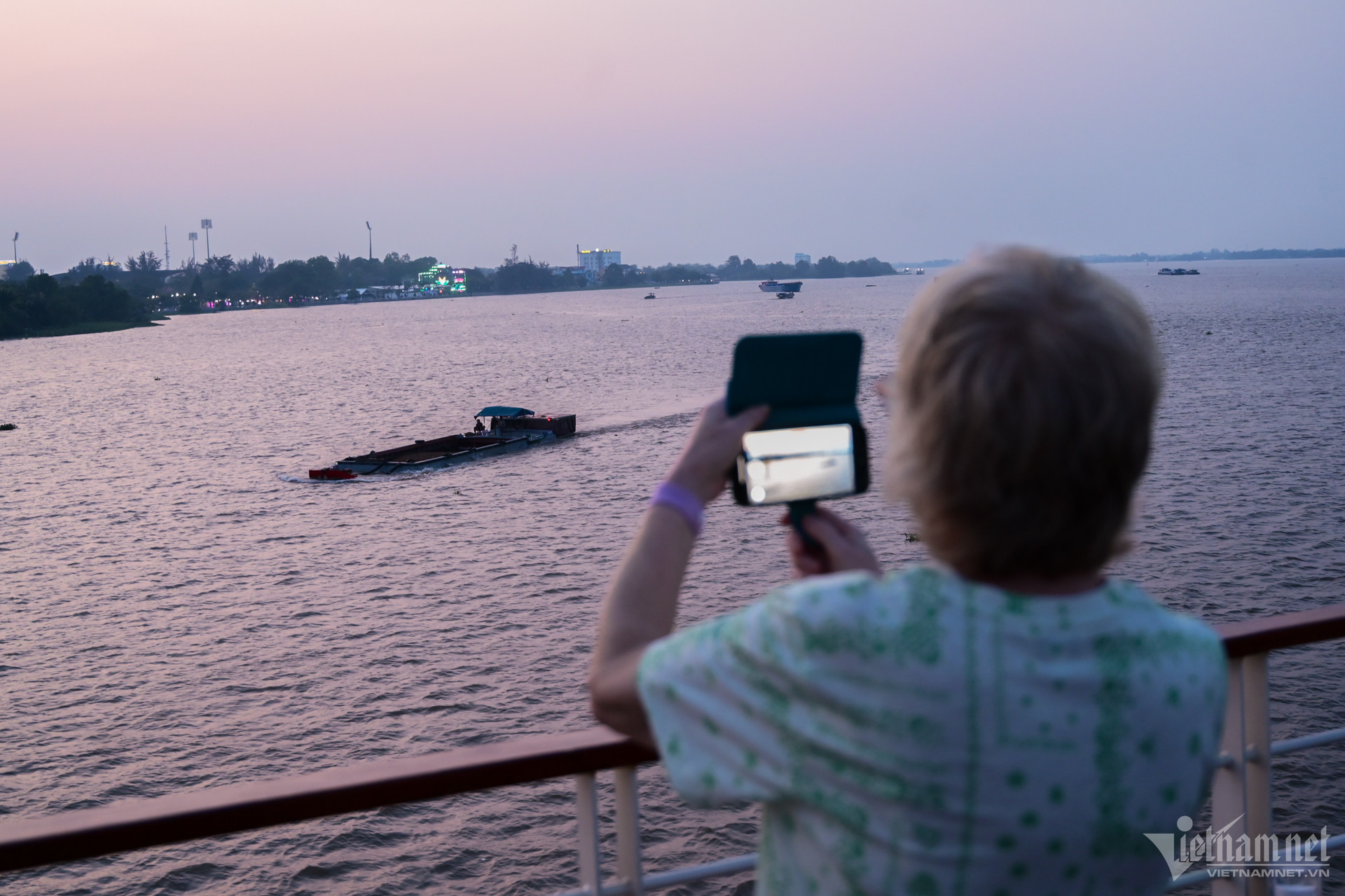VietnamNet would like to introduce a special series by tourism expert Doan Huu Duc, focusing on the development of Vietnam’s river-to-sea tourism. Through in-depth analysis and firsthand insights, the series explores how Vietnam can unlock the full potential of its inland waterways and vast coastline.
From the pioneering efforts of private enterprises like Focus Travel to the strategic significance of regional governance reforms, the series offers a comprehensive vision for transforming the Mekong Delta into a world-class tourism hub.
This is a timely and vital roadmap for integrating river and sea tourism into Vietnam’s broader economic and cultural future.
Sailing through culture: A living delta beyond the riverbanks

This morning, we held a rare and beautiful ceremony - the "điểm nhãn" ritual to bless a newly built "ghe mũi chài lớn," a large-nosed riverboat traditional to the Mekong Delta. This kind of event hasn't happened in over a decade in Rach Ba Dai village, Dong Thap - a place once famed across the region for its generations of master boatbuilders.
Presiding over the ceremony was none other than Mr. Bay Tot, a third-generation craftsman and one of Vietnam's Top 100 honored artisans. He's spent his life building boats by hand, including ocean-worthy vessels over 100 tons. Today, with the river trade fading and highways taking over, he mostly crafts miniatures for display and remembrance. Yet when he nailed the two painted wooden eyes onto the bow - each backed with exactly 9,000 dong for good luck - he whispered with a smile: "These eyes will bring you fortune, little one."
The offerings were simple: incense, flowers, fruit, a teapot, and three ears of corn - a rural pun for success (chắc như bắp). Local media gathered early, knowing how rare this moment was. They, like us, could feel the weight of something much older than ourselves - a ritual passed down by river traders and boatmen when all of the Mekong moved on water.
After building hundreds of boats over the decades, Mr. Bay continues to live humbly and happily at the end of a narrow footpath with his family, where his ancestors began their journey hundreds of years ago. There are no roads, but the river still guides visitors to his house, which remains unchanged. A few real estate and hospitality tycoons have expressed interest in his skills and invited him to leave his cottage and join their mansion, but Bay Tot declined. Until recently, visitors had to hike through the soft earth and weeds to reach his home.
But last month, when I ordered a few miniature boats, I noticed the path had been freshly paved. "Where did this come from?" I asked. He chuckled. "A group of young people from the healing community returned to their roots and started posting videos about me on social media. Soon enough, some backpackers, tourists, and even travel agencies found their way here. With their support, we saved enough to lay a proper cement path - now guests don't have to walk through the mud."
His house is lined with certificates and letters of gratitude - from district officials to the Vietnam President himself. But this short cement path might say the most: it is a quiet reminder that the Mekong still has stories to tell and people willing to listen.
This is not a performance. This is the Mekong - breathing, moving, living.
And the river flows through not only the hands of old masters like Bay Tot, but also the resolve of a new generation. One of them is Ba Lien - a young, pretty woman from Sa Dec who, on paper, has it all: three university degrees, sharp business instincts, and a garden full of pink heritage mandarins so beautiful they seem painted by hand.
But real life in the Delta has never been simple.

Ba Lien left behind the comforts of Sai Gon to return to her family's orchard in Lai Vung, determined to revive their century-old mandarin garden and turn it into an eco-tourism destination. What followed wasn't a romantic countryside dream - it was a grind. Organic farming costs were high. Tourists came, but spent little. Harvests weren't predictable. And she found herself, more than once, wondering if she should go back to the city to teach Japanese, or work for an international company and earn a steadier income.
But she stayed.
Why? Because her vision was bigger than profit. Her team - BaLien Garden - is made up of those society often forgets: members of the LGBT community, former workers from the red-light district seeking a new path, and older laborers rejected by factories. Together, they've won top awards in cooking, tourism, and organic farming at local fairs. Their garden has become a learning ground for university students and biology professors, a place where tourism, education, and healing meet under the shade of mandarin trees.
She doesn't sell fruit. She offers transformation - for her guests, her staff, and anyone who believes that rural tourism can be more than a business model.
Ba Lien doesn't talk much about the hardship, but you see it in the way she welcomes guests with tired eyes and a bright smile. You see it in the way her team, once unsure of their place in the world, now stands tall beside the very trees their grandparents planted.
In the Mekong, water may rise and fall - but purpose, when rooted deep, holds on.
Deeper still, in the silk-weaving villages of Tan Chau, upstream of the Tien River, the Cham community is finding new purpose along the banks of the Mekong. Once known for the luxurious black silk called Lanh My A - a fabric so rich it was worn by nobility and exported across Asia - this craft was nearly lost to time. But as heritage tourism begins to flow upriver, a few determined Cham families are reviving their looms and reconnecting with the river that once carried their silk to the world.
Today, travelers who step off the boat in Tan Chau can visit riverside dyeing houses and watch the dyeing process unfold under the sun. The dyeing process uses mud from the Mekong and fruit from the native Diospyros tree. It's not about selling clothes. It's about telling a story.
The Cham don't separate their craft from their landscape. The silk is the river, and the river is memory. For those who listen closely, a visit to Tan Chau becomes not just a cultural stop but a way to touch something quiet and sacred still flowing beneath the surface.
As Vietnam begins to reform its tourism strategies, cruise infrastructure, and governance models, it's easy to focus on what's being built. But to truly understand the Delta's promise, we must look beyond logistics. We must listen to the voices of the river.
Floating markets like Cai Rang and Phong Dien are not just attractions but cultural and historical institutions that embody centuries of Mekong life and trade. Yet too often, tours only show what floats, missing the fuller story just inland.
Few visitors today stop by the adjacent Cai Rang inland market (nhà lồng chợ Cái Răng), where the tradition of making coffee with a cloth filter has lasted for generations. Sitting there, surrounded by locals and their quiet routines, one might be lucky enough to hear tales of the river's past - when water traders, or thuong ho, had to navigate not only shifting tides but shifting currencies. At one point in time, they traded using three different currencies simultaneously: bills issued by Hanoi, currency from the former southern republic, and U.S. dollars from American soldiers passing through. Archeologists have found ancient Roman coins in the Mekong riverbed near the Oc Eo relics, which are reminders that this river has always been a gateway to the world.
With their layers of living memory, these markets deserve more than a passing glance. They are stories in motion - if we choose to pause long enough to hear them.
Yet their future remains uncertain. Younger generations are departing. Consumer habits are evolving. Tourism presents a lifeline - but only if managed with sensitivity and local participation.
Guess what, those water traders simply do not care. Historically, floating markets and water traders in the Mekong have experienced fluctuations quite a few times. From the 1960s to the 1970s, it was inconsistent due to the war. After 1975, it completely shut down because of the controlled economy (ngăn sông, cấm chợ), but it boomed again in 1986.
What unites them is pride - not in polished museums or five-star hotels, but in the authenticity of life on the water.
The Mekong Delta is a gastronomic treasure. Each bend of the river brings a new flavor - from Ben Tre's coconut candy and My Tho's hu tieu to Can Tho's fermented fish hotpot. Every dish is more than food. It's a narrative of land, climate, and culture. River cruises that offer cooking classes or meals in village homes give tourists an experience that is sensory, social, and deeply rooted.
But culture is not static. Traditional art forms like Hat Boi (classical opera), shadow puppetry, or river temple festivals must now coexist with modern tourism demands. The question isn't whether to preserve or innovate - it's how to do both. Some cruise operators now include performances onboard, while others sponsor community shows at riverside villages.
Tourism in the Delta today isn't just about boat rides or local delicacies. It's about survival. Climate change is no longer a distant theory here - it's in the brackish water creeping into once-fertile paddies, in the floods that don't follow old patterns, and in the riverbanks slipping quietly into the current.
But if there's one thing the people of the Mekong know, it's how to live with the river, not against it. In Dong Thap, farmers are experimenting with floating gardens, adapting to the rhythm of the rising waters. In Soc Trang, homestays built on stilts now use solar panels and simple filtration systems to keep things clean and self-sustaining. And in some corners of the Delta, university students are guiding eco-tours - part classroom, part community project - where visitors learn, locals lead, and nature is not just observed but respected.
Done right, tourism can help this transition. Not by overwhelming the landscape, but by supporting it - bringing in fresh ideas, fair income, and a sense of shared stewardship.
Across the Delta, a quiet wave of young people is returning to their roots - not with nostalgia, curiosity, and care. From university students conducting research in Ba Lien's mandarin orchards to apprentices learning boatbuilding from Bay Tot, the next generation is beginning to see the river not just as a memory, but as a map for the future. Their presence signals hope: that the Mekong will not only be preserved, but lived again and differently.
Because in the end, what makes a journey through the Delta unforgettable isn't just the view. It's drifting past coconut palms while a grandmother hums an old lullaby. It's the taste of tamarind simmered in a family kitchen. It's the quiet realization that Vietnamese, Khmer, Cham, and Hoa have lived together here for centuries - bound not by borders, but by water.
The Mekong Delta is not just a destination. It is a conversation - between tradition and transformation, between host and guest, between river and sea.
As Vietnam continues its reform and investment in tourism, it must not lose sight of the voices that make the Delta real. We need more than hotels and marinas. We need stories. We need people. We need partnerships that place local knowledge at the center.
Because in the end, cruising the Mekong is not about passing through - it's about arriving where Vietnam's heart beats slowest, and strongest.
Doan Huu Duc